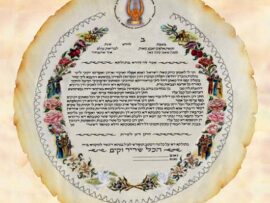It is a fundamental principle of the Jewish faith that G-d's constant presence fills all of existence. Whether one prefers the terminology of the Kabbalists that there is "no space void of Him," of the philosophers who say that G-d is the "First Cause" and "Ongoing Sustainer," or of the popular children's song that declares, "Hashem [G-d] is truly everywhere," the general idea is that G-d is an immanent and accessible presence. Indeed, the prophet Isaiah has a vision of the fiery angels proclaiming "Holy, holy, holy . . . The whole world is filled with His glory," and we repeat this proclamation numerous times during our daily prayers.
Despite these affirmations of G-d’s closeness, mere mortals tend to relate to G-d's presence differently, a result of our human limitations of time and place. And that is the way it is meant to be. We are not supposed to feel the same on a Wednesday afternoon in the winter as we do on Yom Kippur, and we do not perceive G-d's presence in Marlboro, New Jersey, to the same degree we do in Jerusalem.
Even in Jerusalem, Jewish tradition teaches that there are ascending levels of holiness, culminating in the location of the "Holy of Holies" in the Temple -- the most sacred place in the world. It was from this very location that the creation of the world commenced, and so intense is the holiness of this place that it was permitted to be entered only once a year by one individual – the High Priest on Yom Kippur.
Inside the "Holy of Holies" was the ark, which contained the tablets given to Moshe by G-d Himself; a portion of the miraculous manna that fell from the sky to nourish the Jews in the desert; and the wondrous staff of Aaron (Moshe's brother).
All of these special items understandably belong in this sacred place. But there was one prominent item that was seemingly out of place. As we are told in this week’s Torah portion, the ark’s cover had on it two cherubim hammered out of gold, and similar figures were later included in Solomon’s Temple in Jerusalem, as well. These cherubim were so special that we are told that G-d’s “voice” emanated from between them.
What is seemingly strange is how the cherubim looked and “acted.” Kabbalistic tradition tells us that the cherubim had the faces of a male and a female. When the Jewish people were on a high level, the cherubim miraculously would turn towards each other affectionately and embrace, as if to tell the Jewish people, "See how beloved you are to the Almighty, like the love of a man and a woman."
The Talmud tells us that at the time of the destruction of the Temple, the enemy saw this and used it to mock the Jewish people, considering such things to have no correlation with holiness. But they missed the point. Describing the love of a man and a woman as a parable of the love between G-d and the Jewish people, as King Solomon did in the Song of Songs, teaches us a powerful lesson. A loving relationship between a husband and wife is a potential vehicle for holiness, and marriage and the home are building blocks of the Jewish people and receptacles for G-d's presence.
The Holy Zohar tells us that when “the male looks away from the female, woe to the world.” Although this undoubtedly has Kabbalstic interpretations, on a simple level it means that when husband and wife are looking towards each other, always seeking to help and be there for each other, and never turning their eyes to look elsewhere, G-d feels welcome. When this is not the case, the breakdown of the family leads to the breakdown of moral society.
A Kabbalistic teaching at the beginning of this week’s Torah portion says that G-d’s ultimate desire (so to speak) is to dwell “in the midst of every individual.” While today we no longer have the Temple as a focal point of G-d’s presence, having G-d in our midst (even in New Jersey) is still very much possible: We have the Jewish home. As the Talmud teaches, G-d’s presence (shechina) resides among a husband and wife. We may not have the cherubim to allow us to hear His voice, but if we are worthy and listen carefully, we can hear the whisper of His voice in the loving, moral Jewish homes that we build.

